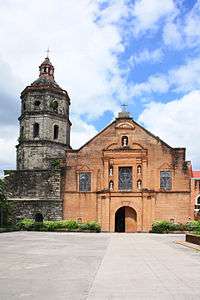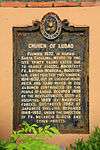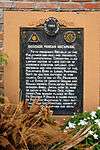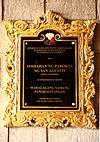San Agustin Church (Lubao)
The San Agustin parish church, also known as the Lubao church, is a 17th-century Neo-classic, Spanish stone and brick church located at Brgy. San Nicolas I, Lubao, Pampanga, Philippines. In 1952, a historical marker bearing a brief history of the structure was installed on the facade of the church by the Historical Committee of the Philippines, precursor of the National Historical Commission of the Philippines. In 2013, the church has been declared by the National Museum of the Philippines as an Important Cultural Property.[1]
| Lubao Church | |
|---|---|
| San Agustin Parish Church | |
 Facade of the San Agustin church in Lubao, Pampanga | |
.svg.png) Lubao Church Location in the Philippines | |
| 14.9386°N 120.6017°E | |
| Location | San Nicolas 1st, Lubao, Pampanga |
| Country | Philippines |
| Denomination | Roman Catholic |
| History | |
| Status | parish church |
| Architecture | |
| Heritage designation | Important Cultural Property |
| Designated | August 2013 |
| Architect(s) | Fr. Antonio Herrera[1] |
| Architectural type | Church |
| Style | Baroque; Neo-Classical |
| Groundbreaking | 1614 |
| Completed | 1638 |
| Specifications | |
| Length | 82.45 metres (270.5 ft) |
| Width | 21.12 metres (69.3 ft) |
| Height | 10.50 metres (34.4 ft) |
| Materials | Sand, gravel, cement, mortar, steel and bricks |
| Clergy | |
| Archbishop | Most. Rev. Florentino G. Lavarias, D.D. |
| Priest(s) | Rev. Fr. Emiliano Dizon |
History
Lubao has been annexed to Tondo as a visita (mission) on May 3, 1572. Soon after, on March 5, 1575, Father Provincial Alfonso Alvarado was assigned to lead the convent of Lubao. The volume of baptisms signed on the baptismal book of Lubao attests to the importance of Lubao as a missionary center.
The history of the current edifice has several versions. One source tells of a Fr. Juan Gallegos, assigned as the first resident priest of Lubao, who organized the early settlement and made the church structures of light materials in a place called Sitio Sapang Pare, a landing place for missionaries coming in from Manila Bay and the tributaries of the Pampanga river. Eventually, the settlement was transferred to its present site. Other sources assert that it was Father Francisco Coronel who founded and established the town at its present site and started building the current edifice. Still other references refute this claim stating that Father Coronel had only stayed in Lubao in 1613 and never came back. Father Jeronimo de Venasque continued the construction in 1635 and it was completed by Father Francisco Figueroa in 1638. Father Antonio Bravo did some repair work in 1877, and in 1893 Father Antonio Moradillo commissioned Italian artists Dibella and Alberoni to paint the ceiling of the nave, along with other ornamentations. The cemetery chapel and stone gate have also been attributed to Father Moradilla. The church and convent were occupied by the Philippine revolutionaries in 1898. They were damaged in 1945 by Japanese bombing during World War II and in 1962 during a strong typhoon. The church was restored in 1954.[2][3]
Architecture
The church measures 82.45 meters long, 21.12 meters wide and 10.50 meters high with stone and brick walls 2.46 meters thick. The five-story bell tower attached to the left of the facade is 31 meters high. The flat surface of facade is bare of ornamentation save for the central retablo of niches, fluted pilasters and Ionic columns in Neoclassical style. The facade has one semicircular-arched main door and three rectangular windows on the second level. The facade is crowned by an imaginary triangular pediment topped by a cross.[2][4] As of 2014, the rough brick surface of the facade had been replaced.
Inscriptions on the Church Structure
To recognize the cultural significance of the San Agustin church, three significant inscriptions have been placed on the church: one from the National Historical Committee, (now the National Historical Commission of the Philippines), the parish of Lubao, and the National Museum of the Philippines:
1952 National Historical Committee Marker
| Inscription - Church of Lubao | Marker |
|---|---|
| Founded in 1572 in Barrio Santa Catalina. Moved to this site thirty years later due to yearly floods. Architect Fr. Antonio Herrera, Augustinian, constructed this church, 1614-1630, out of locally-made brick and sand mixed in egg albumen contributed by the people of Lubao. Occupied 1898 by the Revolutionists. Used as hospital 1899 by American Forces. Destroyed 1942 by Japanese shelling. Repaired 1949-1952, under the direction of Fr. Melencio Garcia and other priests. |  |
1982 Lubao Parish Church Commemorative Marker for President Diosdado P. Macapagal
| Inscription - Diosdado Pangan Macapagal | Marker |
|---|---|
| Fifth President, Republic of the Philippines (1961-1965) and president, 1971 Constitutional Convention, also Lawyer Doctor of Laws Doctor of Economics Educator, Diplomat, Congressman and Vice-President of the Philippines. Born in Lubao, Pampanga Sept. 28, 1910, was baptized in this church, October 12, 1910 by Fr. Francisco de la Banda, of parents Urbano and Romana (Midwife: Escolastica Romero). Sponsor: Angel Javier, Book 32, Page 98, Entry 4. Fr. Pedro Diez, parish priest. This marker placed by Rev. Fr. Gregorio P. Binuya II, parish priest on President Macapagal's 72nd baptismal year for perpetual memory of [his] baptism and birth. |  |
2013 National Museum of the Philippines Marker for Important Cultural Property
In accordance with the requirements of the National Museum in declaring Important Cultural Properties, the San Agustin church has been declared as such because of its significant architectural features and altarpiece.[1] According to the National Museum, the Important Cultural Property title is the second highest title granted by the institution to heritage structures (next to the National Cultural Treasure). Accordingly, the San Agustin church did not pass requirements to be declared a National Cultural Treasure because what remains of the original structure is less than 60 percent.[5]
| Inscription - Important Cultural Property | Marker |
|---|---|
| Approximate English Translation: To its outstanding significance to the Filipino cultural heritage, the parish church of Saint Augustine, Lubao, Pampanga is declared an Important Cultural Property. National Museum, 28 August 2013. |  |
Image Gallery
 Details of the Neo-classic facade
Details of the Neo-classic facade Glorietta
Glorietta View of the side walls
View of the side walls Stations of the Cross relief details
Stations of the Cross relief details Baptismal font
Baptismal font View of the church nave from beneath the choif loft
View of the church nave from beneath the choif loft View of the church nave from the main altar
View of the church nave from the main altar Main altarpiece/retablo
Main altarpiece/retablo Relief of a saint
Relief of a saint Relief of a depiction of Saint Augustine's life
Relief of a depiction of Saint Augustine's life Catholic cemetery gate
Catholic cemetery gate Details of cast iron cemetery gate
Details of cast iron cemetery gate Back view of the catholic cemetery gate
Back view of the catholic cemetery gate Mausoleum
Mausoleum
See also
- List of Cultural Properties in the Philippines
References
- Ramirez, Robertzon. "Lubao Church Declared Cultural Property". www.manilatimes.net. Retrieved 3 November 2014.
- Galende, OSA, Fr. Pedro (1996). Angels in Stone: Architecture of Augustinian Churches in the Philippines (2nd ed.). Manila, Philippines: San Agustin Museum. pp. 117–118. ISBN 9719157100.
- Castro, Alex. "Views from the Pampang - San Agustin Church". www.blogspot.com. Retrieved 3 November 2014.
- Galende, OSA, Fr. Pedro (2007). Philippine Church Facades (1sr ed.). Manila, Philippines: San Agustin Museum. ISBN 978-971-07-2433-8.
- "Lubao Church Declared an ICP". sunstar.com.ph. Retrieved 3 November 2014.
| Wikimedia Commons has media related to Saint Augustine Parish Church in Lubao, Pampanga. |